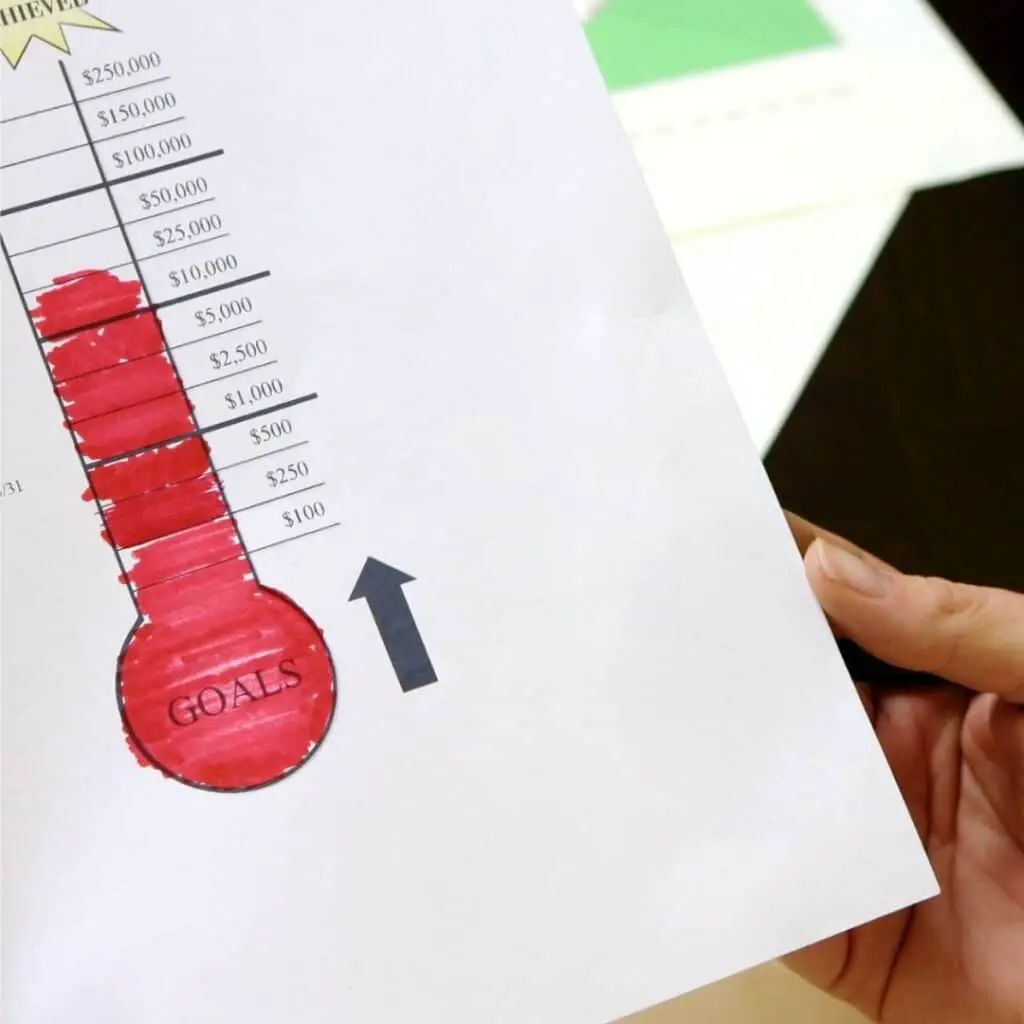*This post may contain affiliate links. As an Amazon Associate we earn from qualifying purchases.
How to save money for short-term goals in 3 Easy Steps. Ready. Set. Go. We’ll make some great choices about where we can save money, earn extra, and use that extra cash to put it in the savings options that best fit our needs.
Ready. Set Your Short Term Savings Goals, put them in writing (even a picture) Get excited and ready to make this happen. Vision boards for both long and short-term savings goals are a great tool. Find what works for you. Be ready to do what it takes to achieve this goal.
Set. Take Steps to set aside money for your goal. Match the best saving plan for the short term with what you hope to achieve. Open a separate account(s). Free up some cash by reviewing your budget and designating some cash to your goal. You can look at making some changes like less take out, canceling a membership, even using coupons on groceries. As a boost can start a side-hustle for extra income, even have a yard sale (remember to update your budget)
Go! Choosing your short-term investment is your final step to getting started. You can look into one or mix n match what works best for you. Savings Banks and Credit Unions, CD’s, Money Market, U.S. Treasury Notes and Bills. There are also savings accounts (and apps) for rounding up (save your spare change) and some that offer new account incentives.
Related: Vision Boards for Financial Success
What Does A Short Term Financial Goal Mean?
A short-term financial goal would be what you put in place prior to setting short-term savings goals. Financial goals would be the ‘big picture goals for things like paying off home, retirement, investment opportunities. To get there securely, you will want to:
- Create and frequently update your budget.
- Reduce Expenses and Increase Income when budget indicates that’s what is needed.
- Emergency Fund.
- Retirement planning (long-term investments).
- Estate planning (secure your worth!).
- Pay down debt (loans, credit cards, student loans, mortgages, etc).
- Identify long-term investment opportunities with your financial planner or bank.
What Determines If A Goal Is Short Term Vs Long Term?
Figuring out how to set money aside for short-term savings goals is a process. It helps to understand some differences between your long and short-term goals.
A short-term goal is usually something short and concrete that has a definite endpoint. For example, saving money for a new laptop or vacation are short-term goals because they have a fixed timeframe attached to them. Saving for a wedding, a new car, and a deposit on a new home are other short-term examples.
Whereas, achieving your long-term goals is more of an ongoing process. Examples of long-term goals are paying off mortgages, saving for retirement, and college savings accounts. Achieving these sorts of goals could take years or decades, and it’s often measured in terms of months and years rather than just days or weeks!
Why is Saving Money A Good Short Term Goal?
People often require something to look forward to, so it is important for us to have a plan in order to reach our goals. Those who are bad at saving may not have set actual goals or reasonable ones that they can actually follow through with.
Understanding how to save money for short-term goals as well as being able to define your short-term savings goals will be helpful for you financially and mentally
Setting goals helps you stay organized with your money. Family trip yet? Saving for that first home can be tough without pre-planning. You want to take your vacation or put a down payment on your first home but might not know how it works. Short term savings is a great way to achieve what you need in the short term and still allow time and flexibility while figuring out long term
Setting goals prevents you from feeling overwhelmed when it comes to the saving process. With small steps, the goal can become more manageable and easier to reach.
It’s easy to spend your money when instant gratification is within reach, but saving for the big items can help you feel less stressed.
An important piece of personal finance involves defining wants and needs.
To know what you can afford, set goals for both conditions. To work towards your goals, it is important to first determine if you can save for them in such a way that they will still leave enough money for the things you need.
Related Reading: Easy Tips for Creating a Budget
A good plan is founded on a clear understanding of your goals for the long-term and the short-term.
Lisa Banks
What Are Examples Of Short Term Savings Goals?
A short-term savings goal means saving to achieve something you want. This would be a 1-5 year goal. Some short term savings goals could be:
- Build an emergency fund. Always first priority for any savings plans. Be sure you have enough to cover unforeseen expenses. A starter emergency fund of 3 months is great. Ideally, 6 months of net salary would be your ultimate savings goal.
- Buying a Home When it comes time to buy a home, short-term savings will cover the down payment and closing costs necessary to buy. If you are lucky enough to have a family member or friend who can provide some funds for a short term saving goal such as this, it’s important to note that short-term savings could be used as an interest-free loan because short-term savings are short term in nature and short-term savings will have a short-term horizon.
- Saving for Travel Saving for travel short-term is a great way to save up some money so that you can take a much-needed vacation or be able to travel with your family without breaking the bank. Whatever your reasons are, short-term savings is short-term in nature so it works well as short-term funding for short-term goals such as traveling.
- Saving up For a New Car, you may want to learn more about short-term auto loans. This can be especially helpful if you are concerned that your current vehicle will no longer be useful in the short-term future. You may also want to consider short-term auto insurance that will help protect you during short-term car loans.
- Saving for a wedding helps you better plan all the wedding details. when you save you are keeping wedding expenses in line with your budgeted amounts. This is typically a 5-year savings plan.
- Save Up Some Extra Cash short-term can help you save extra cash for those nights when you want to go out with friends or buy something new. One of the best ways to make this kind of money work for you is by investing it in a short-term savings account. This will keep your funds liquid and ready for when you need more money.
Financial Security Starts With An Emergency Fund!
Of all your short-term savings goals, this is the one that is most important and should be at the top of your list.
- What is an emergency fund? Money (funds) set aside for unplanned, unexpected, unforeseen expenses.
- Examples of emergency fund reasons or needs. These are only a few. Loss of Job, Medical necessity not covered by insurance, unexpected car repair
- How to calculate how much to save for emergency funds? Take-home (net) pay x 3 months minimum. Ideally 6 months.
- Emergency funds should be saved in available savings accounts, not investment accounts. This money should be available to access (without fees) within 24-48 hours in case of an emergency.
Related Reading: How To Stop Living Paycheck to Paycheck
Goals help you overcome short-term problems.
Hannah More
What Types Of Savings Options Are Available For Short Term Goals?
Match your goals with your savings options. Emergency funds and cash for a fun party with friends should be kept in savings accounts. However, not all savings accounts are created equal so be sure to shop around. Other shorter financial goals can be great for short-term investment options like CD’s, Annuity Funds, and Stocks. Find the best saving plan for the short term that meets your objectives.
Money Market Accounts
Money market accounts are checking accounts that earn higher than most. They are more like a savings account that allows writing a limited amount of checks monthly.
Certificates Of Deposit (Cd’s)
These are accounts where you commit to a certain amount of money kept in the account for a period of time; typically 6 months, 1 year, 3 years. It can pay to keep an eye on CD rates vs high-interest savings accounts. In recent years CDs have been a low rate of return. However, many years ago these could yield 14% interest rates, so they are always worth keeping an eye on. These are good options to consider for shorter savings goals that are 5 years and less. Be certain to know the “rules” as there are early withdrawal penalties.
Online Savings Accounts (Higher Interest)
Today it’s common to find a higher interest rate at an online institution. Check online banking rates compared to your local savings banks and credit unions. Also, be sure to check for promotional rates. They’re still out there and not the free toaster’s from the ’80s! Today you could receive an additional $500 for minimum deposit and direct deposits for a period of time. If you are able to leverage multiple banks with promo’s you could turn your savings into a decent return on investment in a short time.
“Round-up” Savings Apps
These types of savings options are a great way to save, especially if you are one who tends to burn through every cent in your account, living paycheck to paycheck. They’re also fantastic for boosting your savings with little effort.
How round-up savings accounts work is they round to the nearest dollar. You must use your debit card for purchases with this style of savings. For example; if you have a coffee and it cost $2.20, then you are rounding up to $3.00 for a savings of 80cents. If you’re purchasing take-out coffee 7 days a week, that’s an additional $292.00 annually (plus interest!) Fill up your car for $26.25 and you rounded up to 27.00, the .75cents (a week?) goes directly into your savings account (yup, add interest too!) $39.00 annually.
A large number of Americans are using debit cards these days, so to apply this method of savings is a great benefit many more could be using.
3 Easy Steps To Save Money For Short-term Goals
Step 1. Determine The Amount Of Your Short Term Savings Goal
Ready. Determine your goal. Estimate the amount you need to save (exact if you are able). Write it all down. Create a Financial Vision Board. Mindset is a big part of believing in your goals, yourself.
Step 2. Decide The Time You Need To Reach Your Savings Goal
Set. Depending on your savings goal you want to set your savings timeline accordingly. Do you have a 3-year-old car that you want to be prepared to replace in 5 years? Do you have a dream vacation you want to take when the kids are all away in college or before they go? Or are you planning a baby shower in 3-4 months?
Step 3. Choose The Saving Option That Fits Your Short Term Goal
Go! Look into savings accounts first, you can save here while you are investigating other short-term savings options. Always keeping in mind your emergency fund should be in a readily available (no fees for withdrawal) account.
Depending on your time frame, a short-term investment into a CD or other short investment cycle (short-term annuities) could work in your favor. Talk with your financial advisor, a friend who is well educated in Financial Literacy, or your bank.
Take Action! Start Saving now before you come up with a million excuses not to.
Budget Your Short Term Savings Goal As An Expense
Get out the budget and mark these new savings goals under your expenses section. These should be planned as part of your budget now, not tomorrow. By writing this into your expenses you are assuring that you’ve set aside funds to pay your goals, your dreams and making for a much more comfortable future.
Challenge Your Budget to Achieve Your Savings Goals
Challenge yourself to achieve these goals.
Find ways you can save from month to month.
- Possibly carpool, even one day a week or one week a month.
- Learn to make better coffee at home.
- Drop a cable channel or two.
- Cancel a subscription.
- Use apps to save more on purchases that you deem as necessities.
Look into ways to earn extra cash.
- Work an hour of overtime or take a small part-time job.
- Yard Sales online or virtually are great places to save money but yup, you can cash in too!
- Selling on eBay, Etsy, even consignment shops.
- Walk your neighbor’s dog while they’re on vacation
- Food deliveries on weekend evenings (tips are higher then)
Related Reading: Smart, Simple, Sensible Ways to Start Saving Today!
How Can You Save Money But Still Have Short Term Access?
You don’t. Savings is your “expense” remember. You are paying towards your goals, not borrowing from your dreams. Just say “NO”!
Remember, this is temporary, not forever. You are doing this for yourself. It will be oh so worth it.
Once you reach that goal (make a chart if you want), then cha-ching and you are off on that dream vacation, having that brand new car without any debt or even pay for that beautiful wedding.
Each day, you can awake and focus on small, easy goals you can accomplish in the short term – goals that, over time, will lead you to your long-term goal.
Karen Salmansohn
Establishing An Emergency Fund As First Short Term Savings Goal
Most important and the very first thing you need to do (if you haven’t already) is open a savings account for your emergency fund. Do it right away. Not next week, not next month. Right. Away.
Emergency funds are essential in any budget situation. Whether you have massive amounts of wealth or are barely getting by. If you have an unplanned expense or loss of income, it can be devastating. Imagine having nothing but the clothes on your body and now someone took away your shoes? Now, how painful will it be to walk to the store to get another pair of shoes? Once you get there they won’t let you shop (or get credit!) because– no shoes, no shopping.
- Your car breaks down unexpectedly, how do you get to work, the doctors
- Your mortgage or rent depends on two incomes, one person gets very ill and will be out of work for months. Who pays for your basic housing needs?
- You lose your job or are furloughed because of a cutback (or pandemic, who saw that coming?). Sure, you may get unemployment but after deducting for taxes and healthcare needs can you pay your monthly necessities? Housing, Food, Clothing, etc. If you are an entrepreneur these things become even more urgent. You may not even be eligible to collect unemployment.
Look, being a grownup isn’t easy, but the reality of it all is it’s not hard if you follow some simple steps along the way. Take this time to learn how to save money for short-term goals. Stay true to those goals while maintaining your own safety net.
Simple: Add your Emergency fund to your budget as an expense. Once you have reached your amount, that expense is paid off for the time being.
Dream big dreams, but never forget that realistic short-term goals are the keys to your success.
Mac Anderson
Free Resources can be found using google sheets and often times your bank will offer free resources to help you track your goal progress.
Summary
It only takes a few easy steps to create a short-term savings goal by paying yourself as a justified expense from your budget.
Once you understand how to save money for short-term goals and have a short-term savings account(s) set up, it can be easy to save for your goals. Savings accounts are a great way to start saving and motivating yourself towards savings goals such as buying a house or traveling! Getting a short-term savings accounts set up is simple and easy to do. To make sure this is the best financial saving plan for your short term, try to figure out how much exactly it will cost you so that it does not cause you more debt. The most important thing is to keep saving and start living the life you want!
You can do this, believe in yourself.





